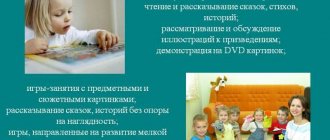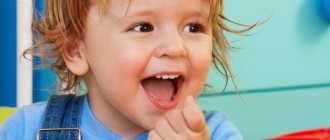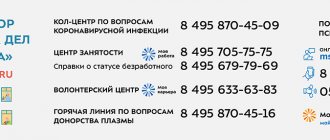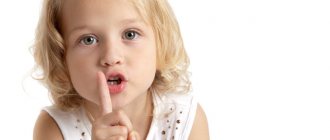After two years, the child begins a period of active development of speech skills: the accumulation of a passive vocabulary, the development of the first simple sentences, sounds become clearer, intonations become richer. But sometimes babies lag significantly behind in the rate of speech development. At the same time, timely assistance provided to them can give noticeable results. For example, speech therapy exercises, which, as is commonly believed, are not particularly necessary for children 2–3 years old. Sometimes it is. And it is important for parents to know exactly when such classes are needed and what to do in such cases.
Features of speech development in children 2-3 years old
At the age of 2-3 years, children have not yet fully developed speech function. Some sounds are not yet perfect; compound words and words with a combination of consonants are difficult to come by. The absence of sounds affects the pronunciation of words. This makes children's speech seem slurred and impure. Children at this age cannot yet fully use the vocal apparatus, are not able to answer questions in a full voice and, if the situation requires it, speak quietly. Usually, at the age of 2-3 years, children learn the pronunciation of many sounds, but they have difficulties with sibilants and the sound “r”, interdental and predental “s”, “z”. Some babies replace hissing and whistling sounds with “d”, “th”.
In the third year of life, children's vocabulary actively accumulates. The number of names of household items and those items that the baby uses infrequently is increasing. He learns case endings, uses verbs, agrees adjectives with nouns. In children’s speech, not only simple but also complex sentences and situational speech appear. Kids respond to adults with monosyllabic sentences. Simultaneously with speech, intensive development of memory, thinking, and imagination occurs. The child accompanies the process of play with speech. He is prone to imitation, actively repeats words after adults, remembers them, and practices correct pronunciation of sounds.
Mathematics
My daughter understands quantity, knows numbers. We count the apples in the store, the number of people in the family and the days in the week. I have prepared materials for comparing quantities and symbols, and I plan to continue the lessons in the future - I see that the child does it with pleasure.
Grandma also has numbers and round circles on magnets. Recently we came to visit them, I attached the numbers to the refrigerator: to number 1 - one round piece, to number 2 - two round pieces. She put the rest in a bowl, and Julia herself attached them to the numbers.
Using the clock puzzle, the child learned to count and understand that numbers can express quantity and order. In the living room there is a clock with hands, and opposite it there is an electronic clock with numbers. Already going to compare the values, but so far only 12 is unmistakably obtained
Using this set we study the numerical meaning of numbers. Next to each number is the number of items.
The child is silent
It happens that children at this age are silent. Parents often seek consultation with this complaint. The child hears everything, understands, but does not speak. At the age of 2-3 years this is not critical. Perhaps the baby is accumulating passive words. There are “lazy” children who don’t need to talk. They are already perfectly understood. Try not to “understand” the child. Tell him that you don’t understand what he needs, don’t fulfill his demands by looking at him or pointing with his finger. Usually, if the baby does not get what he wants, he has to start talking.
If the baby does not speak, then you need to encourage him to talk. The easiest way to get a child to talk is to ask him questions. Sometimes young parents have a misconception that if they are responsible for their child, the child will speak faster. Actually this is not true. He doesn't feel the need to talk. Why should he bother if his mother said everything herself, asked the question herself, answered it herself.
Instead of asking your baby before dinner “will you have soup” and getting an answer in the form of a nod as agreement or a sign of denial with his head, try asking him a clear question: “What will you eat, porridge or soup?” In this way, parents encourage the child to speak. You should not respond to your child’s silent question. For example, a child points at a banana with his finger and whines quietly. Mom worriedly asks the question: “Do you want a banana?” To which he receives an affirmative nod of his head. You should not try to answer silent questions. Tell your child that you don't understand him. Kindly and sympathetically ask him to say what he wants in words.
Housework
It's amazing how much children enjoy doing household chores on their own. At home, tables and chairs were washed, laundry could not be done without a child, and vegetables and dishes were washed only in the sink on the assistant’s tower.
It’s even more amazing how ordinary household chores contribute to the development of a 3-4 year old child:
- the child masters specific everyday skills;
- learns to achieve results;
- feels satisfaction and success, self-confidence;
- learns to concentrate;
- refines movements;
- feels independent and self-reliant;
- forms will through choice;
- masters internal algorithms of activity;
- forms the primary everyday logic, which then forms the basis of any other logic;
- the basis is being prepared for a deeper knowledge of writing, creativity, reading and mathematics;
- feels the limits of his capabilities;
- self-control is formed and the level of aggression decreases.
A separate big task was to arrange a home space for this to make it safe and comfortable. At first there was frustration: where to place it. Then inspiration came and decluttering began - what was unnecessary was sold or thrown away, and a place was found for what was needed. It became more comfortable.
There is still a lot to be done, but I am already seeing the fruits and realizing the importance of including my daughter in my life.
We often cook different dishes together.
Porridge in a slow cooker. I put the measured amount of cereal, salt, sugar, milk, and Yulia mixes and turns on the device.
Salads. She washes vegetables herself, learns to peel, cuts with both a wavy and sharp knife, and an apple slicer. Stirs, adds sauces, spices.
Baked goods - pancakes, pancakes, cheesecakes, muffins, pies, pizzas. Kneads the dough, rolls it out, puts it in molds or cuts out figures, and puts in the filling. I bake or fry.
Meat dishes. Beats the meat and sprinkles with spices.
When we cook, we watch videos on YouTube and do it step by step. I want to try to sketch out a recipe together, and then have her cook according to it.
The child has his own shelf in the kitchen. It contains: dishes, cutlery, cutting boards, knives, graters for cooking, a set for washing vegetables and fruits. An apron hangs on the left, and a dustpan and brush hang on the right to sweep away crumbs from the table.
I made several sets to make it easier for the child to learn new skills.
Polishing. First I suggested polishing the wooden elephant. Julia had not yet finished polishing the entire elephant and was not distracted even once, she was so focused. Then I replaced the elephant with a wooden bowl.
Plant care. I moved the only available flower lower so that my daughter could check if it was time to care for it. I trim the dry leaves myself, but she likes to water and wipe the healthy ones. But the main highlight of the set is the watering can.
Flower arrangement. One day, while walking, we picked flowers and blades of grass, collected autumn leaves and made a bouquet using existing bowls, scissors and a jug.
Ironing. I placed everything I needed in the pantry and made a shelf at a level convenient for the child.
Mopping the floor and sweeping up debris, sweeping up dust. I also placed the necessary tools in the pantry.
Washing dishes. If we cook together, then we wash it together under the tap. To do this, I bought a dishwashing brush and a small dispenser, baby dishwashing detergent.
I myself want to take care of the environment with these materials, it turned out so beautifully. I realized how important details and natural materials are. I would never have thought that I would do decoupage and enjoy the process.
In what cases should you contact a speech therapist?
It should be remembered that all children are individual. It is quite likely that the neighbor’s one-year-old baby began to speak early, in whole sentences, without visible violations of sound pronunciation, and yours has just finished babbling. It all depends on the illnesses suffered, the temperament of the children, their general pace of development, what kind of people surround him, talkative or silent. But there are certain signs that should prompt parents to take their child to a speech therapist:
- There is no interest in toys; all the child’s games are stereotypical and monotonous.
- The kid cannot cope with a simple task, like threading a large bead into a string or building a tower out of cubes.
- Does not understand a simple task, for example, bringing a mug.
- A history of birth injuries or maternal illnesses during pregnancy.
In these cases, the child needs to see a neurologist, speech therapist, or psychologist. After the examination, specialists can prescribe treatment. Moreover, the sooner the baby receives qualified help, the more effective the treatment will be.
Speech development classes at home
To develop a child’s speech, you need to conduct daily activities with him at home that contribute to this.
- Finger games.
Psychologists say that a child’s speech is on his fingers. That is, the development of fine motor skills has a beneficial effect on the development of the brain and, naturally, speech.
- Articulation gymnastics.
Only a well-developed articulatory apparatus will allow the child to clearly pronounce sounds.
- Hearing development.
- Memorizing poetry.
Finger games
Finger gymnastics is movement of the fingers and hands, which can be either active or passive. It includes finger play and massage. Finger gymnastics has the following advantages:
- Speech development
. The same area of the brain is responsible for the development of speech as the development of finger function. The more perfect the small movements, the more perfect the speech.
- Development of the sense of touch.
By working with his fingers, the baby learns to become aware of surfaces, thus developing tactile sensations.
- Development of motor skills.
The more often the baby works with his fingers, the better his coordination and fine movements.
- Memory development.
If finger games are performed with nursery rhymes, rhymes, and combined with a sense of rhythm, then active development of memory occurs.
We offer the following types of finger gymnastics:
- "Lock"
. The child clasps his hands into a “lock”, as if intertwining his fingers. An adult recites a simple rhyme and swings the “castle” to the side. “There is a lock on the door, who could open it? They knocked, here you need to knock with the child’s palms, without disengaging the fingers from each other, twisted, without disengaging the fingers, the child seemed to be twisting the brush, pulled, at this word the hands lightly stretch in different directions. And they opened it, the handles moved wide to the sides.
- Brush.
The child connects the pads of his fingers and swings the hand left and right with movements of the wrist and fingers. To the left - the fingertips are connected, to the right - they move apart. At the same time, the adult says the words: “I will paint the table and chair, Masha the cat, with a soft brush.”
- Knead the dough
. We knead the dough, we knead it, the child shows a movement that imitates the process of kneading the dough, we press the dough, we press it, we vigorously squeeze and unclench our fingers, we bake pies, we “make” a snowball with our hands.
Before finger gymnastics, it is better to get a massage. First, the child’s hands are warmed up, then each finger individually.
Articulation gymnastics
Articulatory gymnastics ensures the correct pronunciation of sounds. It allows you to strengthen the muscles of the speech apparatus, making them more mobile. Articulation gymnastics should be done while sitting at a table in front of a large mirror. The parent demonstrates each exercise himself, and the child’s task is to clearly repeat after him. Classes should be daily, lasting no more than 15 minutes. You can use the following exercises at home with your parents:
- "Kitty"
. The child opens his mouth wide, his tongue is wide and sluggish, imitating the movements of a cat as it laps up milk.
- "Shovel"
. The baby's mouth is wide open, a calm, soft tongue lies on the lower lip. After which the tongue hides in the “house”.
- "Proboscis".
The lips are pulled forward as long as possible, imitating the trunk of an elephant.
- "Hamster"
. The baby's mouth is closed, his cheeks are puffed out. This position is maintained for 5 seconds. After which the air is exhaled.
- "Frog"
. The child stretches his lips as much as possible in a smile, showing how a frog smiles.
Developing hearing
The formation of pronunciation depends on how well the child hears. The development of phonemic hearing will allow the baby to distinguish sounds and compare his speech with the speech of others. By the age of 3, children can already distinguish vowel sounds, voiced and hard consonants quite well. In order for their hearing to develop, we suggest performing tasks to differentiate the volume of a sound and recognize the object that makes this sound.
- We turn on the sounds of simple animals for the child, dogs, cats, hedgehogs, cows. We ask him to guess who “spoke.” Then we complicate the task, adding the sound of a hammer, washing machine, kettle, etc.
- We invite the child to find any sound in the words. We pronounce words in which the sound is at the beginning of the word, in the middle, at the end. The child’s task is to guess in which part of the word the given sound is located.
- We come up with words with a given sound.
- Stomp, clap if you hear the specified sound.
Reading, memorizing poetry
Thanks to reading and memorizing poems that are easy to pronounce, the child expands his horizons, his active vocabulary increases, his memory develops, and his general cultural level increases. In order for the activities to benefit the baby, you need to remember the simple rules that parents should follow:
- Give your child the opportunity to choose a book.
- Don't read “scary” books at night.
- Before you start reading, get to know the work yourself and evaluate whether your child will like it or not.
- Read with expression, not mechanically.
- Read regularly.
It is useful to look at books with bright pictures with children. Let the child name who is in the picture. For this purpose, it is better to use books about animals. Ask how the animal talks. Learning their “language” helps in mastering many sounds. Pay more attention to those animals that you can meet on the street. You can play at your home zoo by placing toys and saying the sounds that the animal makes.
Any activities with a child should be in the form of a game, at those moments when he feels good and is ready to cooperate with an adult. If you put pressure on children, they will withdraw, and there will definitely be no benefit from such activities. With systematic training with your child, success will be noticeable very quickly.
Articulation gymnastics for stuttering
Stuttering is a speech problem that is sometimes difficult to treat. Success can only be achieved through daily training.
Articulatory gymnastics for stuttering is one of the best, because it is aimed at strengthening the muscles of the articulatory apparatus.
Examples of exercises:
- inflate your cheeks, release air, inflate each cheek in turn;
- clap your lips together (like a fish);
- press your tongue on one or the other cheek in turn;
- puff out your cheeks while closing your mouth, then hit your cheeks with your fists to release the air noisily;
- bite the upper and then the lower lip.
The age of early development (2-3 years) is a short, but truly unique period of life, when the child’s brain is programmed for intensive formation and learning. Parents should pay special attention to the child, because it is at this time that the foundation is laid for the development of the baby’s speech and thinking.









